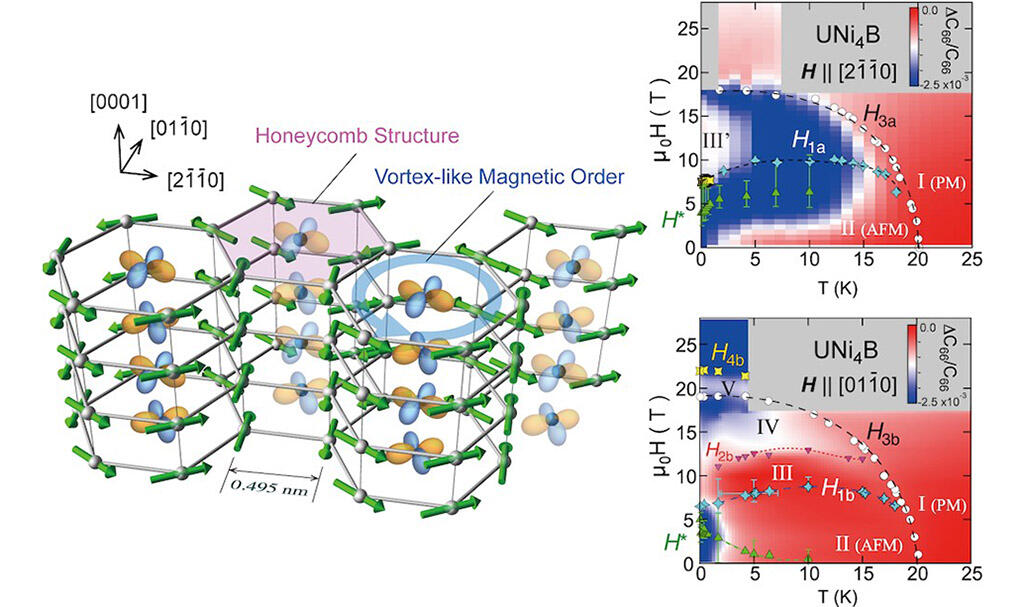An international collaboration of Associate Professor Tatsuya Yanagisawa of Hokkaido University School of Science; Institute for Materials Research, Tohoku University; Helmholtz Zentrum Dresden-Rossendorf (Germany), Dresden University of Technology; and Department of Mathematical Physics, Charles University (Czech Republic) succeeded, for the first time, in capturing the existence of an electric quadrupole that maintains an unordered degree of freedom at the center of a magnetic vortex formed by a honeycomb compound (UNi4B). The research group is investigating the properties of extended multipoles in the "toroidal order" in which electron spins on the honeycomb structure of UNi4B are ordered in a spiral manner. Thus far, they have observed, for the first time, the phenomenon through which additional magnetization is induced in the magnetic toroidal ordered phase when an electric current is flowing. However, the role of the orbital degree of freedom, which is another degree of freedom of the electron, had not yet been clarified. Therefore, they tried to observe the response of the orbital degree of freedom by using ultrasonic waves.

(Credit: Professor Yanagisawa)
Ultrasonic waves present on a solid propagate as elastic waves and induce local strain in the coupling lattice. The local strain derives from the orbital degrees of freedom of the electrons, and this strain combines with an electric quadrupole with an anisotropic local charge distribution that has the same symmetry. By precisely measuring the speed of sound of ultrasonic waves, the elastic constant (spring constant of a solid) can be obtained, and the change in temperature and magnetic field can be understood as the sensitivity of the electrical quadrupole freedom of electrons in a solid. To verify this, the research group used multiple UNi4B single crystal samples grown and evaluated separately at Hokkaido University and Charles University (uranium compounds cannot be exported overseas due to legal regulations). Cryogenic and strong-magnetic-field experiments were conducted in Japan and Germany.
First, through the experiments at Helmholtz Zentrum Dresden-Rossendorf, we revealed the beginning of a new order of electronic state of UNi4B in the unexplored region of 20 Tesla or more and 4 Kelvin or less. To verify this, the researchers combined a refrigerant-free hybrid magnet from the Institute for Materials Research, Tohoku University, with a dilution refrigerator. Furthermore, they addressed the challenge of precision ultrasonic measurement in a complex extreme environment under a low temperature and strong magnetic field, and they discovered a new ordered phase (Phase V). They found that the electric quadrupole plays an important role in the uranium compound-based vortex magnetic structure. Associate Professor Yanagisawa said, "In the future, we aim to comprehensively clarify the ordered phase newly discovered in cryogenic and high-magnetic-field regions. If it becomes possible to freely control the degrees of freedom of a robust electric quadrupole under a magnetic field, it is expected to be applied to new quantum memories and quantum devices that are robust against a magnetic field. In addition, we would like to continue searching for functional materials by performing similar ultrasonic measurements on various uranium compounds in many unexplored regions."
This article has been translated by JST with permission from The Science News Ltd.(https://sci-news.co.jp/). Unauthorized reproduction of the article and photographs is prohibited.




